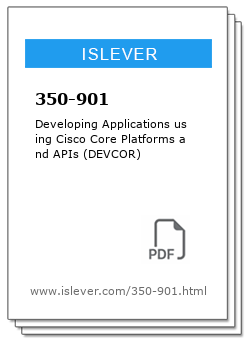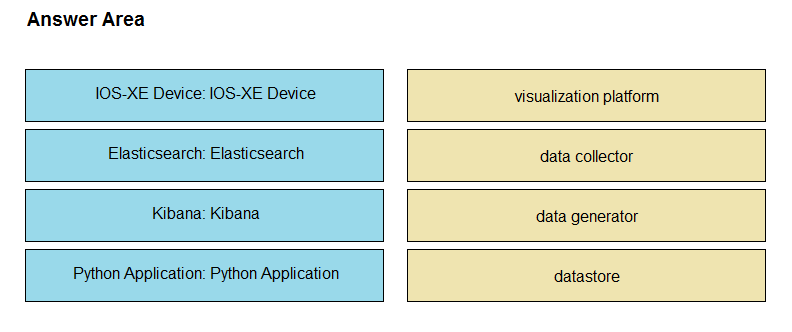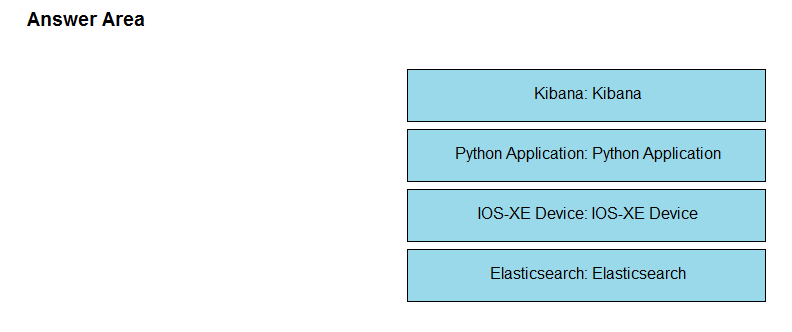Description

Exam 350-901: Developing Applications using Cisco Core Platforms and APIs (DEVCOR)
|
Unlock the Shortcut to Quick Exam Success with 350-901 Mock Tests! Tried and tested by countless students, our 350-901 Tests are your express ticket to acing the 350-901 exam. Packed with the latest exam questions and answers, these study materials are designed to save you precious time and energy. Say goodbye to the stress of exam preparation and hello to your coveted certification. Our study materials come in PDF format, featuring a comprehensive collection of exam questions. Developing Applications using Cisco Core Platforms and APIs (DEVCOR). Master these questions, and you're well on your way to passing the exam with flying colors. |
DEMO
Question #1
A developer has created an application based on customer requirements. The customer needs to run the application with the minimum downtime.
Which design approach regarding high-availability applications, Recovery Time Objective, and Recovery Point Objective must be taken?
- A. Active/passive results in lower RTO and RPO. For RPO, data synchronization between the two data centers must be timely to allow seamless request flow.
- B. Active/passive results in lower RTO and RPO. For RPO, data synchronization between the two data centers does not need to be timely to allow seamless request flow.
- C. Active/active results in lower RTO and RPO. For RPO, data synchronization between the two data centers does not need to be timely to allow seamless request flow.
- D. Active/active results in lower RTO and RPO. For RPO, data synchronization between the two data centers must be timely to allow seamless request flow.
Answer: D
Question #2
DRAG DROP -
An application is being built to collect and display telemetry streaming data. Drag and drop the elements of this stack from the left onto the correct element functions on the right.
Select and Place:

Answer:

Question #3
A cloud native project is being worked on in which all source code and dependencies are written in Python, Ruby, and/or JavaScnpt. A change in code triggers a notification to the CI/CD tool to run the CI/CD pipeline.
Which step should be omitted from the pipeline?
- A. Deploy the code to one or more environments, such as staging and/or production.
- B. Build one of more containers that package up code and all its dependencies.
- C. Compile code.
- D. Run automated tests to validate the code.
Answer: C
Question #4
Which two statements are considered best practices according to the 12-factor app methodology for application design? (Choose two.)
- A. Application code writes its event stream to stdout.
- B. Application log streams are archived in multiple replicated databases.
- C. Application log streams are sent to log indexing and analysis systems.
- D. Application code writes its event stream to specific log files.
- E. Log files are aggregated into a single file on individual nodes.
Answer: AC
Question #5
An organization manages a large cloud-deployed application that employs a microservices architecture. No notable issues occur with downtime because the services of this application are redundantly deployed over three or more data center regions. However, several times a week reports are received about application slowness. The container orchestration logs show faults in a variety of containers that cause them to fail and then spin up brand new.
Which action must be taken to improve the resiliency design of the application while maintaining current scale?
- A. Update the base image of the containers.
- B. Test the execution of the application with another cloud services platform.
- C. Increase the number of containers running per service.
- D. Add consistent ג€try/catch(exception)ג€ clauses to the code.
Answer: D
Question #6
How should a web application be designed to work on a platform where up to 1000 requests per second can be served?
- A. Use algorithms like random early detection to deny excessive requests.
- B. Set a per-user limit (for example, 5 requests/minute/user) and deny the requests from the users who have reached the limit.
- C. Only 1000 user connections are allowed; further connections are denied so that all connected users can be served.
- D. All requests are saved and processed one by one so that all users can be served eventually.
Answer: B
Question #7 ... 391
Developing Applications using Cisco Core Platforms and APIs (DEVCOR)
Note: The 350-901 DEMO includes only a small portion of the actual product content. To access the complete material, please consider purchasing the product. Upon purchase, you'll receive a PDF file containing the entire content.
Additionally, our 350-901 brain dumps has been curated to exclude outdated, invalid, and erroneous information, ensuring a more effective learning experience for you.